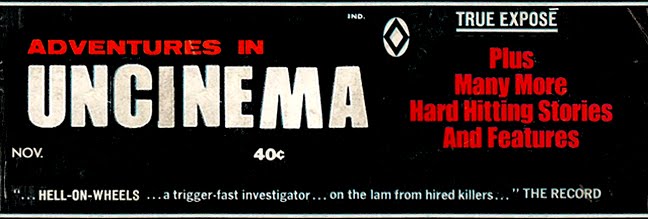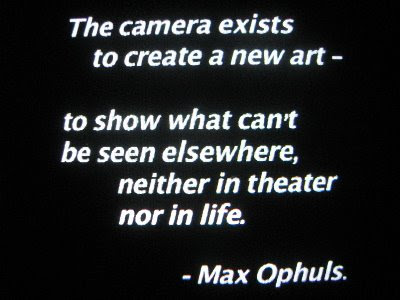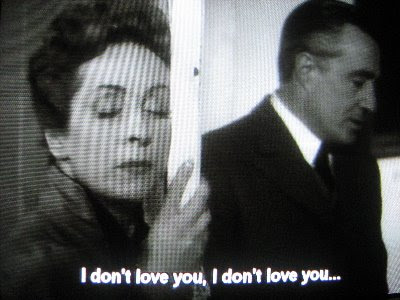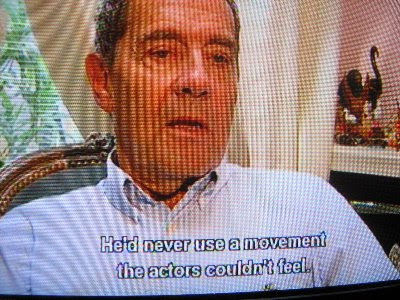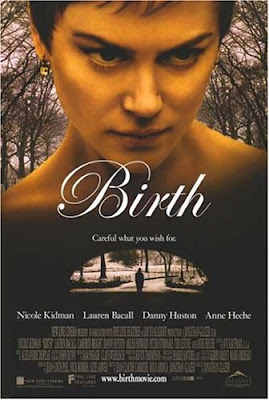'Night Train Murders' is an Italian version of the 'Last House on the Left' story, but with certain significant differences. The story concerns two young women friends, played by Laura D'Angelo and Irene Miracle (the first in a triumvirate of Argento actors in the film - she later played the woman at the start of Inferno), taking the night train to Italy to visit one of the girls parents.
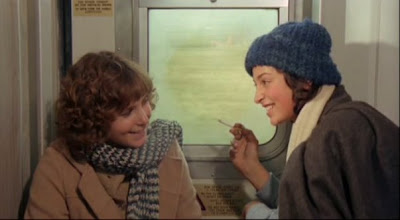 (Incidentally, the numerous scenes of people smoking on the train brought wistful sighs from the two ex-smokers in the room, like they were sharing a Proustian moment of emotional memory. Except with fags instead of madeleines.)
(Incidentally, the numerous scenes of people smoking on the train brought wistful sighs from the two ex-smokers in the room, like they were sharing a Proustian moment of emotional memory. Except with fags instead of madeleines.)Also on the train are two young criminals, Blackie and Curlie (I know, they sound more Bash Street Kids than sadistic killers), played by Flavio Bucci (who later played the blind piano player in Suspiria) and Gianfranco de Grassi.
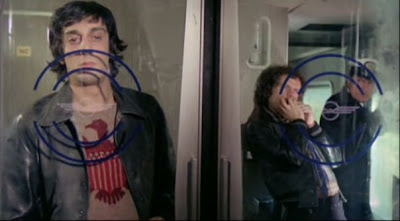 They establish their thug credentials early on, by mugging an admittedly pissed-up Santa Claus in broad daylight.
They establish their thug credentials early on, by mugging an admittedly pissed-up Santa Claus in broad daylight.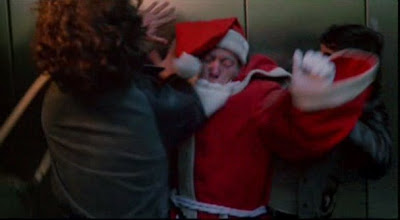 The train is packed, standing room only, and as the women and the thugs search for a seat, we meet the other passengers, a carriage full of jovial Nazis, a group of priests, one of whom, it is implied, has a paedophile's eye (although his travelling companion suggests it's 'just a twitch') and a carriage that is occupied by Pat Butcher, Winston Churchill and Michael Foot.
The train is packed, standing room only, and as the women and the thugs search for a seat, we meet the other passengers, a carriage full of jovial Nazis, a group of priests, one of whom, it is implied, has a paedophile's eye (although his travelling companion suggests it's 'just a twitch') and a carriage that is occupied by Pat Butcher, Winston Churchill and Michael Foot.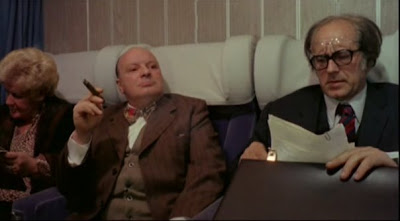 Also in this carriage is a smartly dressed posh woman, played by Macha Méril (who later played the psychic in 'Deep Red' - another strong influence on 'Deliver Me' - it's like this film was made for me...)
Also in this carriage is a smartly dressed posh woman, played by Macha Méril (who later played the psychic in 'Deep Red' - another strong influence on 'Deliver Me' - it's like this film was made for me...) 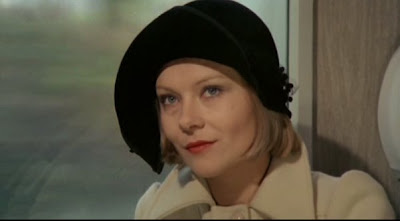 Outwardly respectable, a hint to her true character is revealed when she drops a book letting free a pornographic photo which she hurriedly puts away. Not soon after, on going to the toilet, she is assaulted by Blackie, who locks himself in with her. The assault turns into mutually consenting sex (importantly, there's no idea that the woman is enjoying a rape, more that she is character who likes to keep up appearances, but is actually quite debauched).
Outwardly respectable, a hint to her true character is revealed when she drops a book letting free a pornographic photo which she hurriedly puts away. Not soon after, on going to the toilet, she is assaulted by Blackie, who locks himself in with her. The assault turns into mutually consenting sex (importantly, there's no idea that the woman is enjoying a rape, more that she is character who likes to keep up appearances, but is actually quite debauched).When the train is forced to stop because of a bomb scare, the two young women are pointed towards a near-empty connecting train which will take them home overnight. Unfortunately for them, also joining the train are the two thugs and the posh woman, now seemingly in cahoots. With the carriage cut off from access to the rest of the train by a faulty door handle, the two women are subjected to a series of assaults, growing in violence and coordinated mainly by the female character, who is constantly pushing the two men to go further. Also joining in on the act is a middle-aged middle-class passenger who is also trapped in the carriage by the faulty door handle, who begins by voyeuring the whole scene, then is pulled in (it has to be said quite willingly) to rape one of the girls.
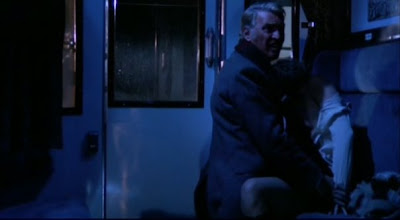 The whole sequence is filmed in a blueish light, with a soundtrack, led by harmonica, which incorporates the sound of the train and makes the whole thing relentless and grim.
The whole sequence is filmed in a blueish light, with a soundtrack, led by harmonica, which incorporates the sound of the train and makes the whole thing relentless and grim. As with 'Last House...' the attack ends in the death of the two young women. The thugs and the posh woman then leave the train at the same stop where the girl's parents are waiting.
As with 'Last House...' the attack ends in the death of the two young women. The thugs and the posh woman then leave the train at the same stop where the girl's parents are waiting. I'd really forgotten how big fur was in the Seventies. Anyway, through a set of random circumstances/contrived coincidences, they all end up at the house of the parents, none of them aware of the identity of the others, until a report about the discovery of two women's bodies comes on the radio...
I'd really forgotten how big fur was in the Seventies. Anyway, through a set of random circumstances/contrived coincidences, they all end up at the house of the parents, none of them aware of the identity of the others, until a report about the discovery of two women's bodies comes on the radio...'Night Train Murders' is truly horrible and wrong, but much less sleazy than I was expecting. The main way in which the film differs from 'Last House on the Left' is in the implication of the complicity of the middle-classes in the violence - the middle-class characters in the film also pointedly discuss 'violent society' at a number of points in the film - with the main antagonist - at least in terms of driving the violence if not participating fully - getting away pretty much scott free at the end. The film is nicely shot, especially the train sequences and is full of great little details - like the carriage full of 'Seig Heil'-ing Nazis, or the Santa mugging - as well as moments which stick in your mind for long afterwards.
Next up was the Thai film 'Shutter', about a photographer and his girlfriend haunted by a ghost from his past.
 Although pretty much full of East Asian horror cliches - ghostly woman creeping around/appearing out of nowhere/looking through her long black hair
Although pretty much full of East Asian horror cliches - ghostly woman creeping around/appearing out of nowhere/looking through her long black hair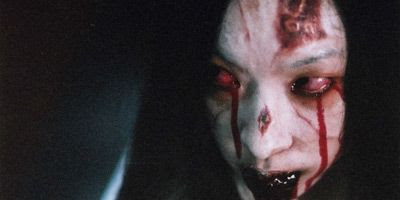 - the film was full of authentic jumps and had a nicely evovling story concerning the central character. It's recently been remade in the States and it'll be interesting to see how much of the story they stick too.
- the film was full of authentic jumps and had a nicely evovling story concerning the central character. It's recently been remade in the States and it'll be interesting to see how much of the story they stick too.Finally we had the Seventies Australian eco-horror film 'The Long Weekend'.
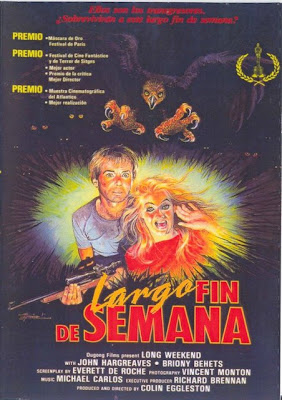 Essentially a two-hander about a bickering married couple going for a weekend trip to the beach, the film is quite slow and eerie, but does feature a zombie manatee, and you don't get to write that phrase very often. The performances were great and it had some nice moments of absolute HusbandDickery (although to be fair, there was quite a lot of WifeDickery as well) - particularly the bits where he just pisses about, fucking up the environment for the heck of it. (As soon as they set up camp, he starts chopping down a tree - when his wife asks him what he's doing it for, he just shrugs 'I dunno'). Interestingly, the director Colin Eggleston is also listed on Imdb as having made, the year before, a film called 'Fantasm Comes Again' an Australian softcore portmanteau, featuring, amongst other things, 'Explicit Sex, Anal Rape,Lesbianism,Male Frontal Nudity,Nude Wearing Glasses and Non Statutory Female On Male Rape'. I've got to say, I'd never heard of him before, but he's bloody versatile.
Essentially a two-hander about a bickering married couple going for a weekend trip to the beach, the film is quite slow and eerie, but does feature a zombie manatee, and you don't get to write that phrase very often. The performances were great and it had some nice moments of absolute HusbandDickery (although to be fair, there was quite a lot of WifeDickery as well) - particularly the bits where he just pisses about, fucking up the environment for the heck of it. (As soon as they set up camp, he starts chopping down a tree - when his wife asks him what he's doing it for, he just shrugs 'I dunno'). Interestingly, the director Colin Eggleston is also listed on Imdb as having made, the year before, a film called 'Fantasm Comes Again' an Australian softcore portmanteau, featuring, amongst other things, 'Explicit Sex, Anal Rape,Lesbianism,Male Frontal Nudity,Nude Wearing Glasses and Non Statutory Female On Male Rape'. I've got to say, I'd never heard of him before, but he's bloody versatile.With that (and with John Ross having, customarily, fallen asleep on the sofa) we were done. Next up, with the release of 'The Third Mother' imminent, we might plan on an Argento trilogy, although myself and Cooke might end up being the only takers...
